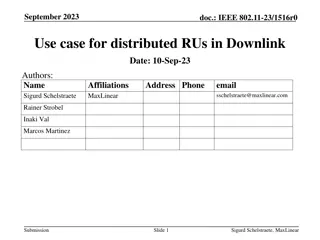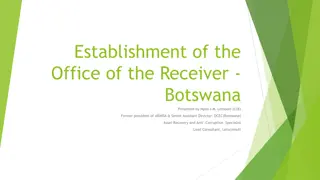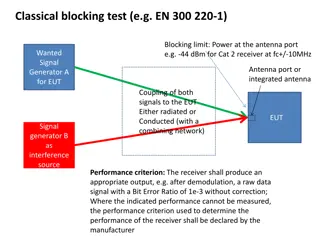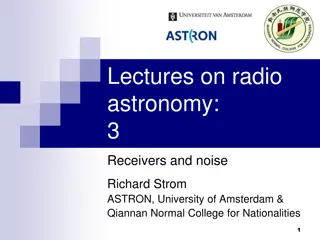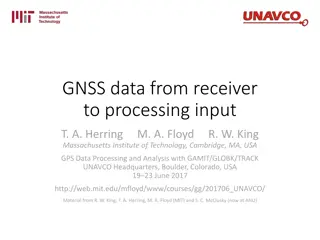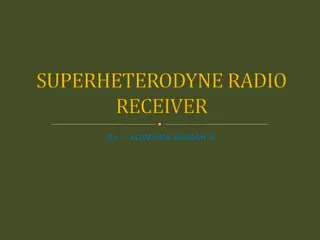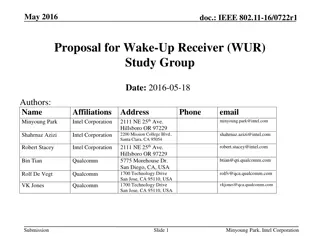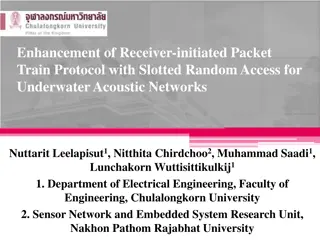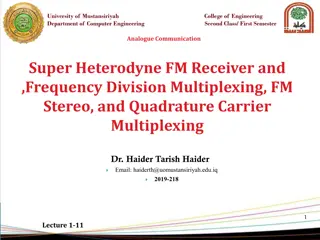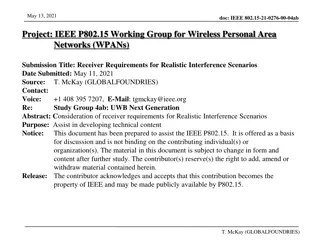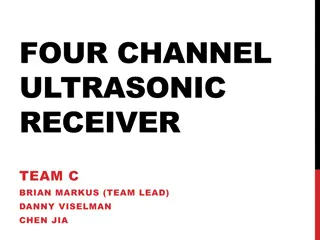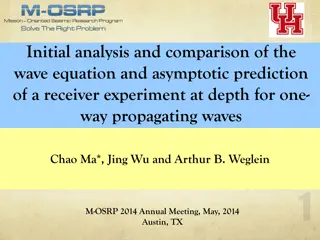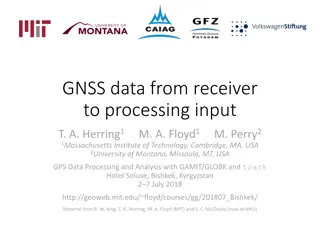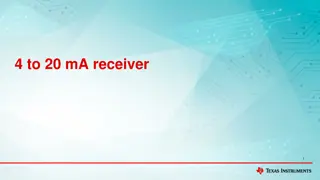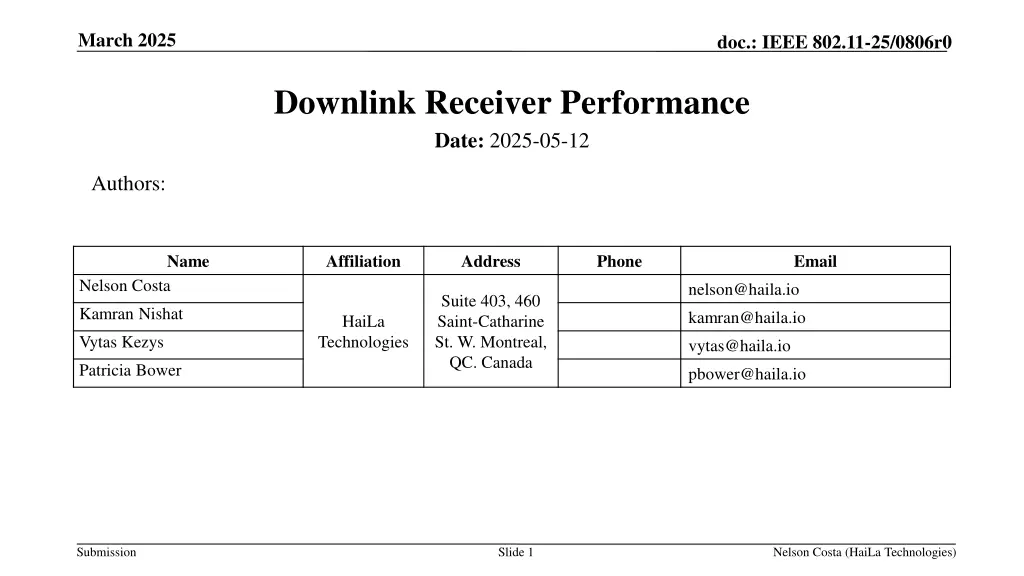
IEEE 802.11-25/0806r0 Downlink Receiver Performance Analysis
Explore the analysis of downlink receiver performance in IEEE 802.11-25/0806r0 document, focusing on AMP STA and comparing different waveforms. Understand the implications of waveform choices on receiver models and performance metrics such as BER at varying data rates. Key considerations like LPF design, noise figure, and synchronization in receiver models are discussed.
Download Presentation

Please find below an Image/Link to download the presentation.
The content on the website is provided AS IS for your information and personal use only. It may not be sold, licensed, or shared on other websites without obtaining consent from the author. If you encounter any issues during the download, it is possible that the publisher has removed the file from their server.
You are allowed to download the files provided on this website for personal or commercial use, subject to the condition that they are used lawfully. All files are the property of their respective owners.
The content on the website is provided AS IS for your information and personal use only. It may not be sold, licensed, or shared on other websites without obtaining consent from the author.
E N D
Presentation Transcript
March 2025 doc.: IEEE 802.11-25/0806r0 Downlink Receiver Performance Date: 2025-05-12 Authors: Name Affiliation Address Phone Email Nelson Costa nelson@haila.io Suite 403, 460 Saint-Catharine St. W. Montreal, QC. Canada Kamran Nishat kamran@haila.io HaiLa Vytas Kezys Technologies vytas@haila.io Patricia Bower pbower@haila.io Submission Slide 1 Nelson Costa (HaiLa Technologies)
March 2025 doc.: IEEE 802.11-25/0806r0 Abstract In the following, we present a basic analysis of the receiver performance at an AMP STA. We compare the receiver performance using the four different downlink waveforms analyzed in [1]. The goal is to move toward some commonality in an AMP STA receiver model, so that we can compare different waveforms under a common framework. Submission Slide 2 Nelson Costa (HaiLa Technologies)
March 2025 doc.: IEEE 802.11-25/0806r0 Background In [1] we presented a spectral analysis of four proposed downlink waveforms. [2-3] proposed two different spreading sequences to create a DSSS modulated base sequence. [4] proposed an OFDM symbol based-waveform. The group has also discussed using the L-LTF as a base waveform. In general, that analysis showed The DSSS base waveforms did not meet the ETSI power spectral density limit of 10dBm/1MHz. The OFDM base waveforms exhibited notably high Peak-to-Average Power ratios. None of the proposed waveforms were compatible with PSK backscatter. Submission Slide 3 Nelson Costa (HaiLa Technologies)
May 2025 doc.: IEEE 802.11-25/0806r0 AMP STA Receiver Model Inputs are the filtered and normalized waveforms from [1]. Sim sample rate of 60/66 MHz for OFDM/DSSS waveforms. 10 MHz ADC Perfect timing sync assumed. Submission Slide 4 Nelson Costa (HaiLa Technologies)
May 2025 doc.: IEEE 802.11-25/0806r0 AMP STA Receiver Model: Things Missing LPF design greatly affects receiver performance. [5] Analyzes BER versus LPF type and parameters. Noise Figure. Front-end bandwidth. ADC quantization. Sync sequence and timing recovery for the data sequence. How many models? (Active Tx, Close range monostatic, bistatic) Submission Slide 5 Nelson Costa (HaiLa Technologies)
May 2025 doc.: IEEE 802.11-25/0806r0 BER Performance: 250 kbps All the DSSS based waveforms perform equally as well as regular Manchester encoded OOK with no base waveform. The OFDM based waveforms show about a 2 dB improvement at 1% BER. Submission Slide 6 Nelson Costa (HaiLa Technologies)
May 2025 doc.: IEEE 802.11-25/0806r0 BER Performance: 1 Mbps All the DSSS based waveforms perform about 2 dB worse than Manchester encoded OOK with no base waveform at 1 % BER. The OFDM based waveforms show about a 3 dB improvement over DSSS based waveforms. The OFDM based waveforms show about a 1 dB improvement over Manchester encoded OOK with no base waveform at 1% BER. Submission Slide 7 Nelson Costa (HaiLa Technologies)
May 2025 doc.: IEEE 802.11-25/0806r0 BER Performance: Receiver Sensitivity At 1% BER, shifting from 250 kbps to 1 Mbps means degrading receive sensitivity by About 4-5 dB for the OFDM base waveforms. About 6 dB for DSSS based waveforms. About 4 dB for Man-OOK with no base waveform. 1 Mbps 250 kbps Submission Slide 8 Nelson Costa (HaiLa Technologies)
March 2025 doc.: IEEE 802.11-25/0806r0 Conclusion Here, we presented an analysis of DL receiver performance. We also proposed that we should standardize on a few receiver models in order to make a fair comparison between proposals. Prefer three models, 1) active Tx, 2) close range monostatic backscatter, 3) bistatic backscatter. We created a common framework for simulating BER performance across three proposed downlink waveforms. Overall receiver performance with proposed waveforms, At 250 kbps, the OFDM-based waveforms had about a 2 dB advantage over the DSSS waveforms. At 1 Mbps, the OFDM-based waveform had about a 3 dB advantage over the DSSS waveforms. Moving from 250 kbps to 1 Mbps degrades receiver sensitivity by about 4 6 dB Slide 9 Submission Nelson Costa (HaiLa Technologies)
May 2025 doc.: IEEE 802.11-25/0806r0 Straw Poll 1 Do you agree that 11bp should define at least one standard receiver model? Submission Slide 10 Nelson Costa (HaiLa Technologies)
May 2025 doc.: IEEE 802.11-25/0806r0 Straw Poll 2 Do you agree that 11bp should define at least three receiver models for the following topologies. Active Transmit Close-Range Monostatic Backscatter Bistatic Backscatter. Submission Slide 11 Nelson Costa (HaiLa Technologies)
March 2025 doc.: IEEE 802.11-25/0806r0 References [1] Costa et al., Downlink Waveform Analysis, 11-25/0771, May 2025. [2] Li et al., AMP DL Wideband OOK Generation, 11-24/0050, January 2025. [3] Wang et al., Follow-up on AMP DL OOK generation, 11-25/0440, March 2025. [4] Shellhammer et al., AMP Downlink Bandwidth Control using OFDM Spreading Waveform, 11- 25/0325, March 2025. [5] Wilhelmsson et al., Discussion of a Wake-Up Receiver Front-End Model, 11-17/0093, January 2017. Submission Slide 12 Nelson Costa (HaiLa Technologies)

